A Comprehensive Analysis of Food, Health, and Nutrition Principles
VerifiedAdded on 2022/08/24
|5
|818
|22
Essay
AI Summary
This essay provides a comprehensive overview of food, health, and nutrition, defining key concepts such as nutrition, nutrients, health promotion, and disease prevention. It elaborates on the scientific method's application in nutritional research, exemplified by the discovery of iodine. The essay further explores the roles of genetics, environment, lifestyle, and lifecycle in determining health status, emphasizing the interplay between genomics and nutrition. It also outlines methods for assessing personal health status and diet, including physical examinations, biochemical tests, and dietary assessments. The document concludes by highlighting the importance of understanding these factors for maintaining optimal health and well-being. Desklib provides access to this and many other solved assignments for students.
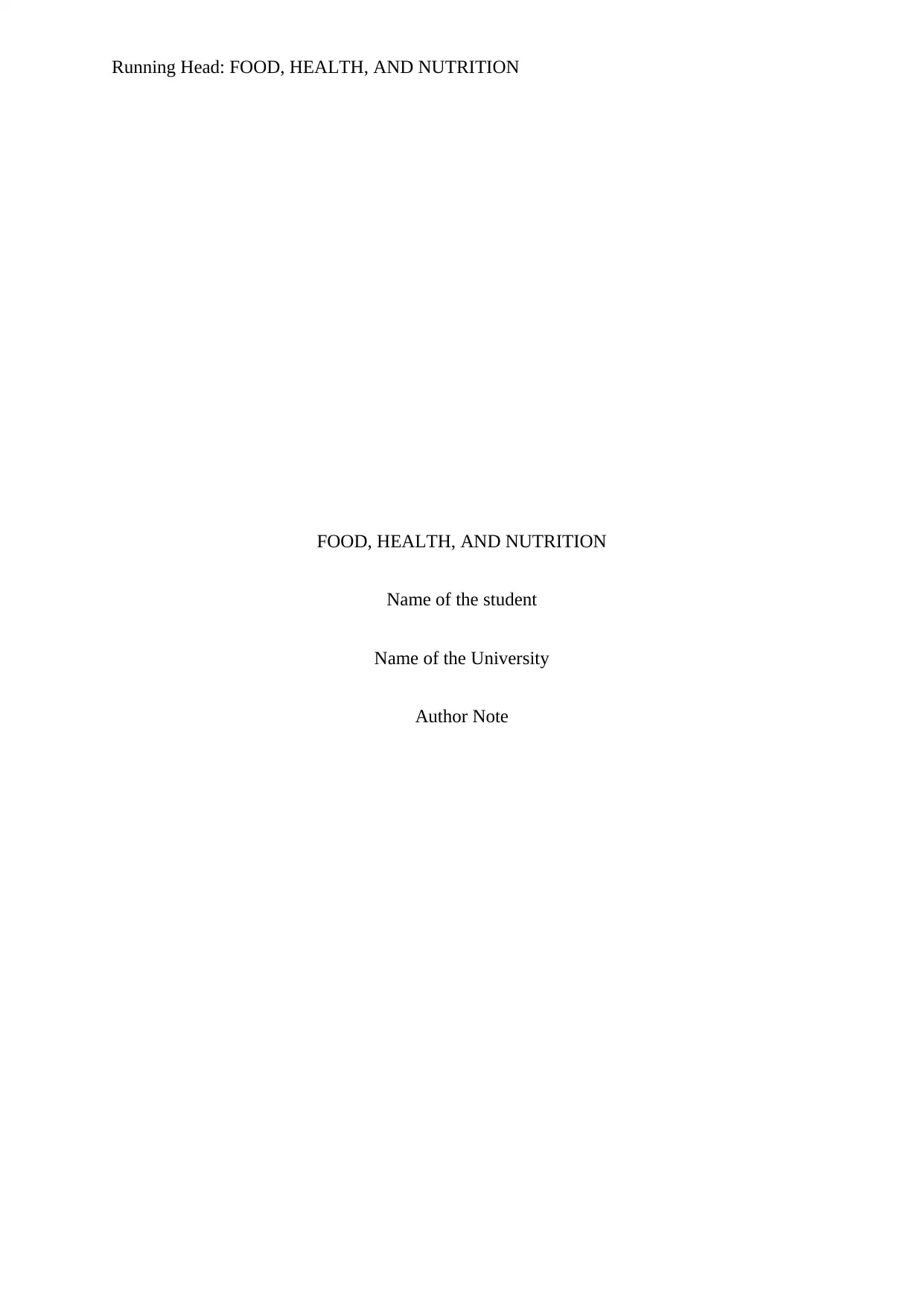
Running Head: FOOD, HEALTH, AND NUTRITION
FOOD, HEALTH, AND NUTRITION
Name of the student
Name of the University
Author Note
FOOD, HEALTH, AND NUTRITION
Name of the student
Name of the University
Author Note
Paraphrase This Document
Need a fresh take? Get an instant paraphrase of this document with our AI Paraphraser
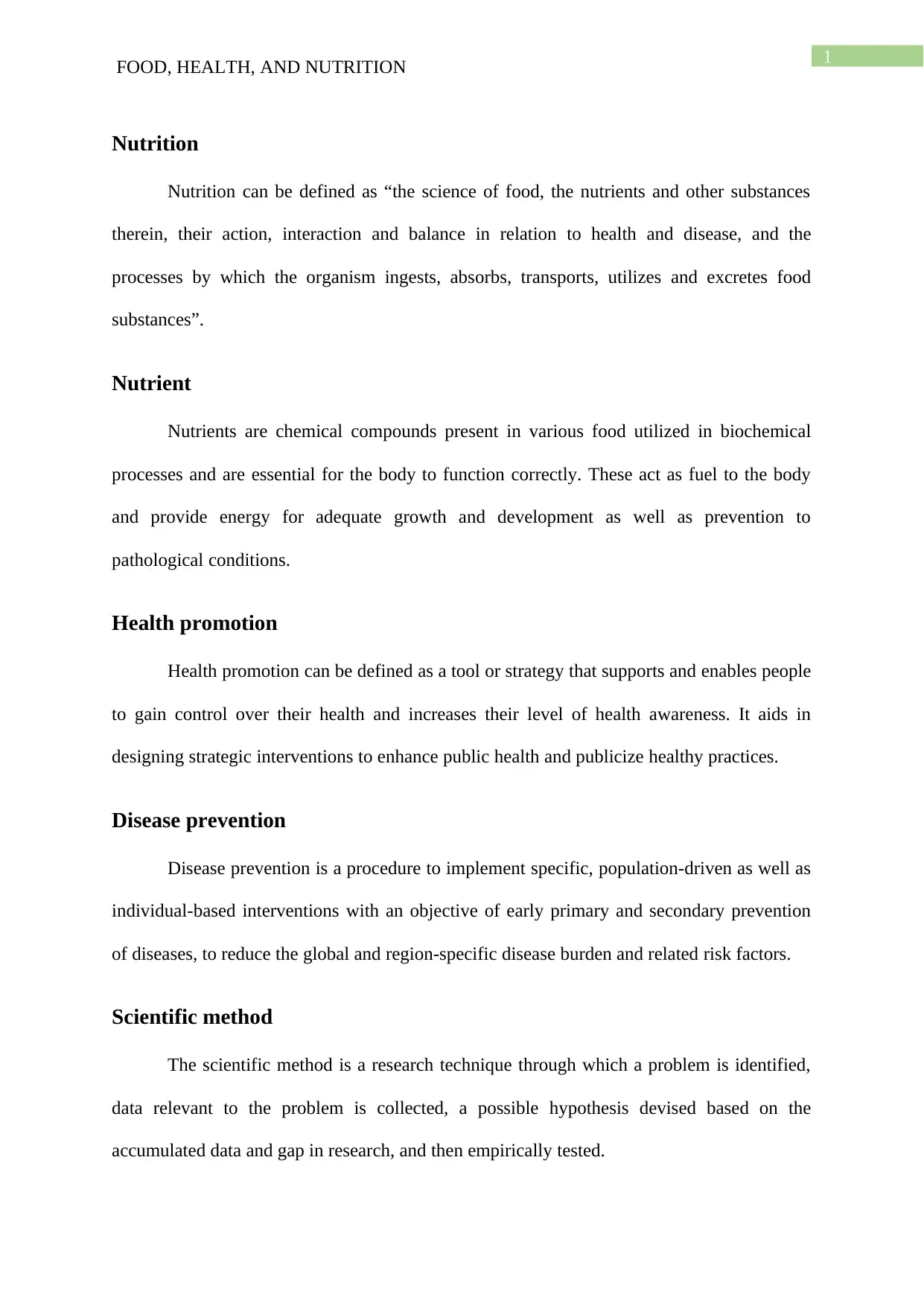
1
FOOD, HEALTH, AND NUTRITION
Nutrition
Nutrition can be defined as “the science of food, the nutrients and other substances
therein, their action, interaction and balance in relation to health and disease, and the
processes by which the organism ingests, absorbs, transports, utilizes and excretes food
substances”.
Nutrient
Nutrients are chemical compounds present in various food utilized in biochemical
processes and are essential for the body to function correctly. These act as fuel to the body
and provide energy for adequate growth and development as well as prevention to
pathological conditions.
Health promotion
Health promotion can be defined as a tool or strategy that supports and enables people
to gain control over their health and increases their level of health awareness. It aids in
designing strategic interventions to enhance public health and publicize healthy practices.
Disease prevention
Disease prevention is a procedure to implement specific, population-driven as well as
individual-based interventions with an objective of early primary and secondary prevention
of diseases, to reduce the global and region-specific disease burden and related risk factors.
Scientific method
The scientific method is a research technique through which a problem is identified,
data relevant to the problem is collected, a possible hypothesis devised based on the
accumulated data and gap in research, and then empirically tested.
FOOD, HEALTH, AND NUTRITION
Nutrition
Nutrition can be defined as “the science of food, the nutrients and other substances
therein, their action, interaction and balance in relation to health and disease, and the
processes by which the organism ingests, absorbs, transports, utilizes and excretes food
substances”.
Nutrient
Nutrients are chemical compounds present in various food utilized in biochemical
processes and are essential for the body to function correctly. These act as fuel to the body
and provide energy for adequate growth and development as well as prevention to
pathological conditions.
Health promotion
Health promotion can be defined as a tool or strategy that supports and enables people
to gain control over their health and increases their level of health awareness. It aids in
designing strategic interventions to enhance public health and publicize healthy practices.
Disease prevention
Disease prevention is a procedure to implement specific, population-driven as well as
individual-based interventions with an objective of early primary and secondary prevention
of diseases, to reduce the global and region-specific disease burden and related risk factors.
Scientific method
The scientific method is a research technique through which a problem is identified,
data relevant to the problem is collected, a possible hypothesis devised based on the
accumulated data and gap in research, and then empirically tested.
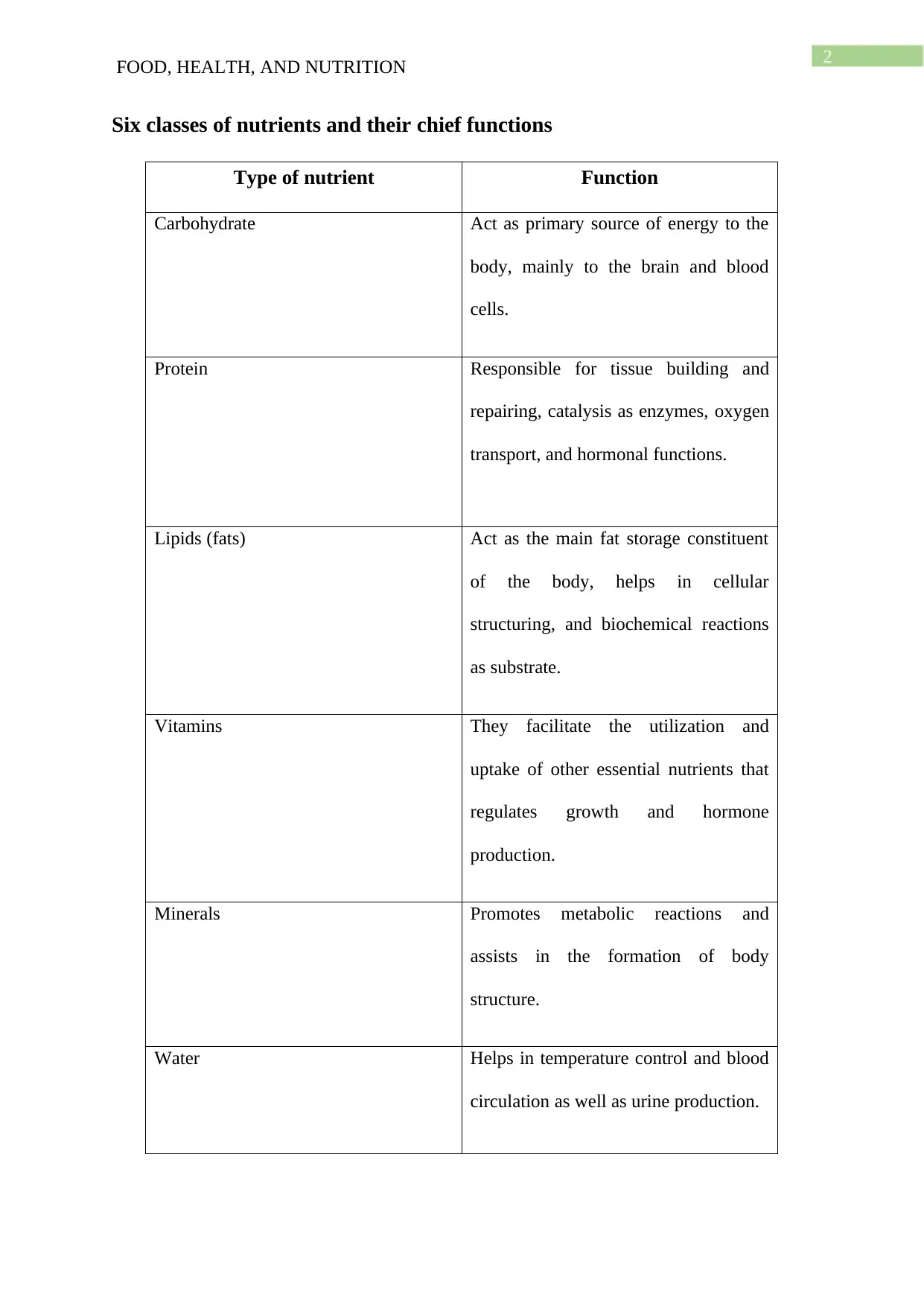
2
FOOD, HEALTH, AND NUTRITION
Six classes of nutrients and their chief functions
Type of nutrient Function
Carbohydrate Act as primary source of energy to the
body, mainly to the brain and blood
cells.
Protein Responsible for tissue building and
repairing, catalysis as enzymes, oxygen
transport, and hormonal functions.
Lipids (fats) Act as the main fat storage constituent
of the body, helps in cellular
structuring, and biochemical reactions
as substrate.
Vitamins They facilitate the utilization and
uptake of other essential nutrients that
regulates growth and hormone
production.
Minerals Promotes metabolic reactions and
assists in the formation of body
structure.
Water Helps in temperature control and blood
circulation as well as urine production.
FOOD, HEALTH, AND NUTRITION
Six classes of nutrients and their chief functions
Type of nutrient Function
Carbohydrate Act as primary source of energy to the
body, mainly to the brain and blood
cells.
Protein Responsible for tissue building and
repairing, catalysis as enzymes, oxygen
transport, and hormonal functions.
Lipids (fats) Act as the main fat storage constituent
of the body, helps in cellular
structuring, and biochemical reactions
as substrate.
Vitamins They facilitate the utilization and
uptake of other essential nutrients that
regulates growth and hormone
production.
Minerals Promotes metabolic reactions and
assists in the formation of body
structure.
Water Helps in temperature control and blood
circulation as well as urine production.
⊘ This is a preview!⊘
Do you want full access?
Subscribe today to unlock all pages.

Trusted by 1+ million students worldwide
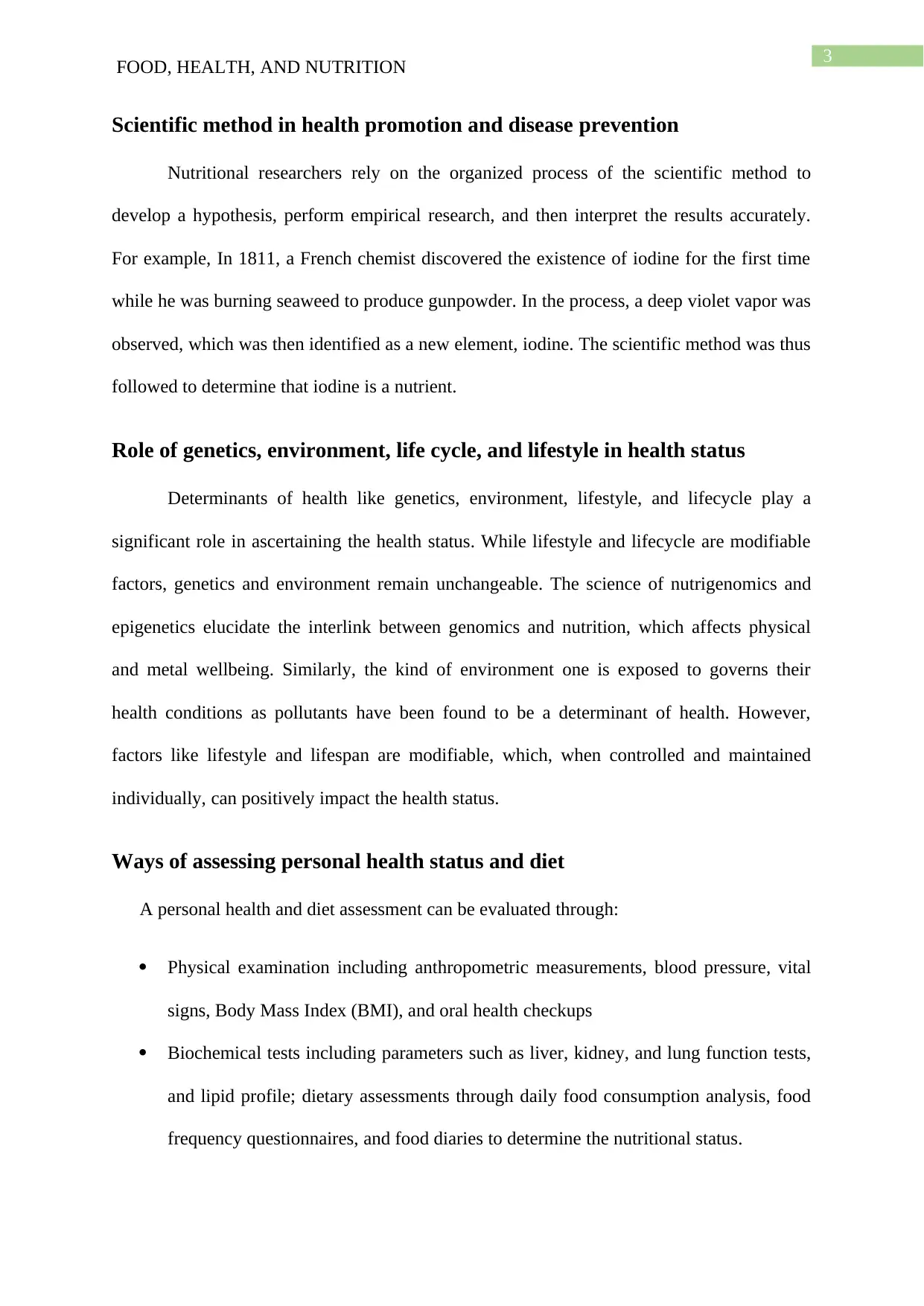
3
FOOD, HEALTH, AND NUTRITION
Scientific method in health promotion and disease prevention
Nutritional researchers rely on the organized process of the scientific method to
develop a hypothesis, perform empirical research, and then interpret the results accurately.
For example, In 1811, a French chemist discovered the existence of iodine for the first time
while he was burning seaweed to produce gunpowder. In the process, a deep violet vapor was
observed, which was then identified as a new element, iodine. The scientific method was thus
followed to determine that iodine is a nutrient.
Role of genetics, environment, life cycle, and lifestyle in health status
Determinants of health like genetics, environment, lifestyle, and lifecycle play a
significant role in ascertaining the health status. While lifestyle and lifecycle are modifiable
factors, genetics and environment remain unchangeable. The science of nutrigenomics and
epigenetics elucidate the interlink between genomics and nutrition, which affects physical
and metal wellbeing. Similarly, the kind of environment one is exposed to governs their
health conditions as pollutants have been found to be a determinant of health. However,
factors like lifestyle and lifespan are modifiable, which, when controlled and maintained
individually, can positively impact the health status.
Ways of assessing personal health status and diet
A personal health and diet assessment can be evaluated through:
Physical examination including anthropometric measurements, blood pressure, vital
signs, Body Mass Index (BMI), and oral health checkups
Biochemical tests including parameters such as liver, kidney, and lung function tests,
and lipid profile; dietary assessments through daily food consumption analysis, food
frequency questionnaires, and food diaries to determine the nutritional status.
FOOD, HEALTH, AND NUTRITION
Scientific method in health promotion and disease prevention
Nutritional researchers rely on the organized process of the scientific method to
develop a hypothesis, perform empirical research, and then interpret the results accurately.
For example, In 1811, a French chemist discovered the existence of iodine for the first time
while he was burning seaweed to produce gunpowder. In the process, a deep violet vapor was
observed, which was then identified as a new element, iodine. The scientific method was thus
followed to determine that iodine is a nutrient.
Role of genetics, environment, life cycle, and lifestyle in health status
Determinants of health like genetics, environment, lifestyle, and lifecycle play a
significant role in ascertaining the health status. While lifestyle and lifecycle are modifiable
factors, genetics and environment remain unchangeable. The science of nutrigenomics and
epigenetics elucidate the interlink between genomics and nutrition, which affects physical
and metal wellbeing. Similarly, the kind of environment one is exposed to governs their
health conditions as pollutants have been found to be a determinant of health. However,
factors like lifestyle and lifespan are modifiable, which, when controlled and maintained
individually, can positively impact the health status.
Ways of assessing personal health status and diet
A personal health and diet assessment can be evaluated through:
Physical examination including anthropometric measurements, blood pressure, vital
signs, Body Mass Index (BMI), and oral health checkups
Biochemical tests including parameters such as liver, kidney, and lung function tests,
and lipid profile; dietary assessments through daily food consumption analysis, food
frequency questionnaires, and food diaries to determine the nutritional status.
Paraphrase This Document
Need a fresh take? Get an instant paraphrase of this document with our AI Paraphraser
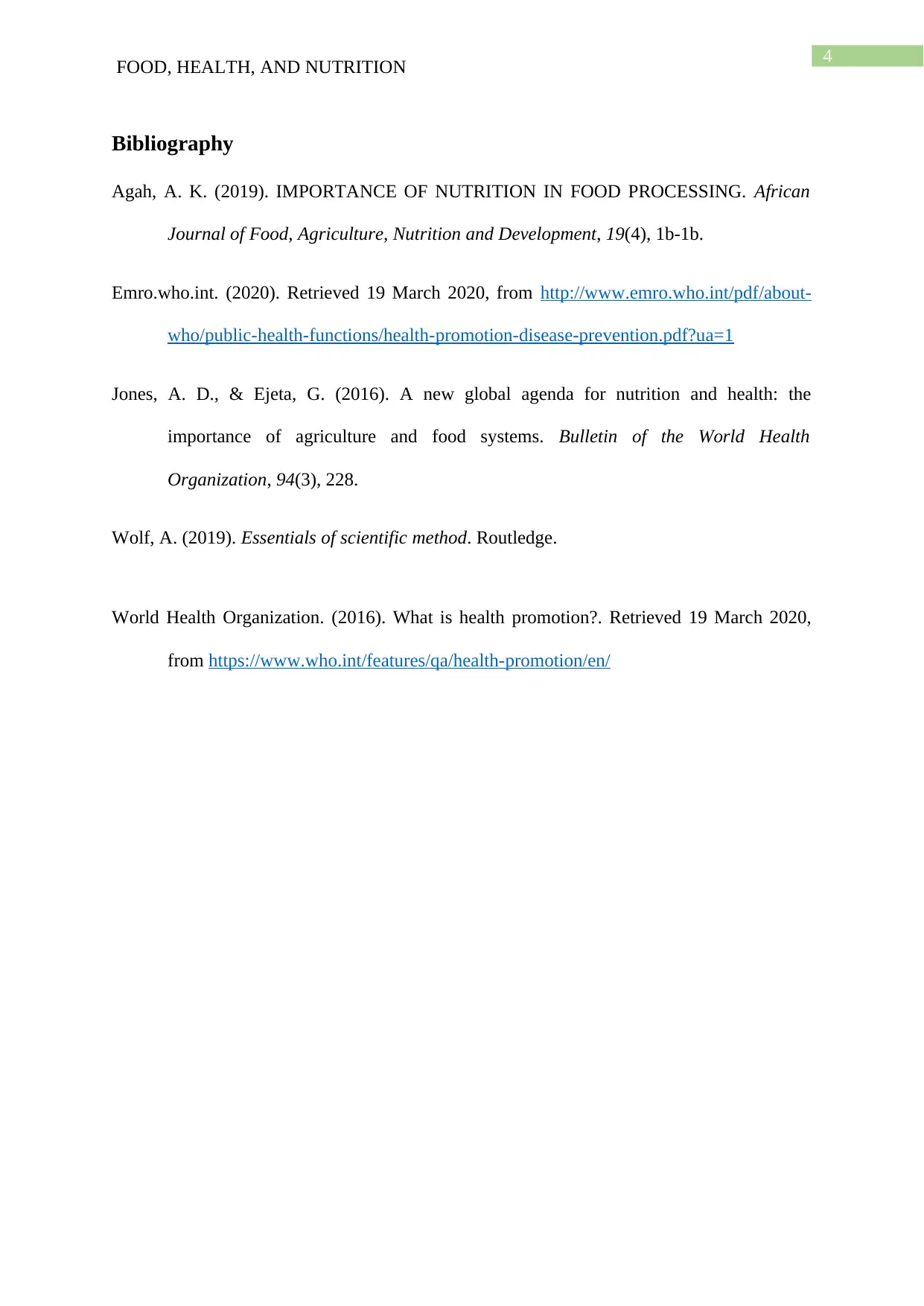
4
FOOD, HEALTH, AND NUTRITION
Bibliography
Agah, A. K. (2019). IMPORTANCE OF NUTRITION IN FOOD PROCESSING. African
Journal of Food, Agriculture, Nutrition and Development, 19(4), 1b-1b.
Emro.who.int. (2020). Retrieved 19 March 2020, from http://www.emro.who.int/pdf/about-
who/public-health-functions/health-promotion-disease-prevention.pdf?ua=1
Jones, A. D., & Ejeta, G. (2016). A new global agenda for nutrition and health: the
importance of agriculture and food systems. Bulletin of the World Health
Organization, 94(3), 228.
Wolf, A. (2019). Essentials of scientific method. Routledge.
World Health Organization. (2016). What is health promotion?. Retrieved 19 March 2020,
from https://www.who.int/features/qa/health-promotion/en/
FOOD, HEALTH, AND NUTRITION
Bibliography
Agah, A. K. (2019). IMPORTANCE OF NUTRITION IN FOOD PROCESSING. African
Journal of Food, Agriculture, Nutrition and Development, 19(4), 1b-1b.
Emro.who.int. (2020). Retrieved 19 March 2020, from http://www.emro.who.int/pdf/about-
who/public-health-functions/health-promotion-disease-prevention.pdf?ua=1
Jones, A. D., & Ejeta, G. (2016). A new global agenda for nutrition and health: the
importance of agriculture and food systems. Bulletin of the World Health
Organization, 94(3), 228.
Wolf, A. (2019). Essentials of scientific method. Routledge.
World Health Organization. (2016). What is health promotion?. Retrieved 19 March 2020,
from https://www.who.int/features/qa/health-promotion/en/
1 out of 5
Related Documents
Your All-in-One AI-Powered Toolkit for Academic Success.
+13062052269
info@desklib.com
Available 24*7 on WhatsApp / Email
![[object Object]](/_next/static/media/star-bottom.7253800d.svg)
Unlock your academic potential
Copyright © 2020–2025 A2Z Services. All Rights Reserved. Developed and managed by ZUCOL.




